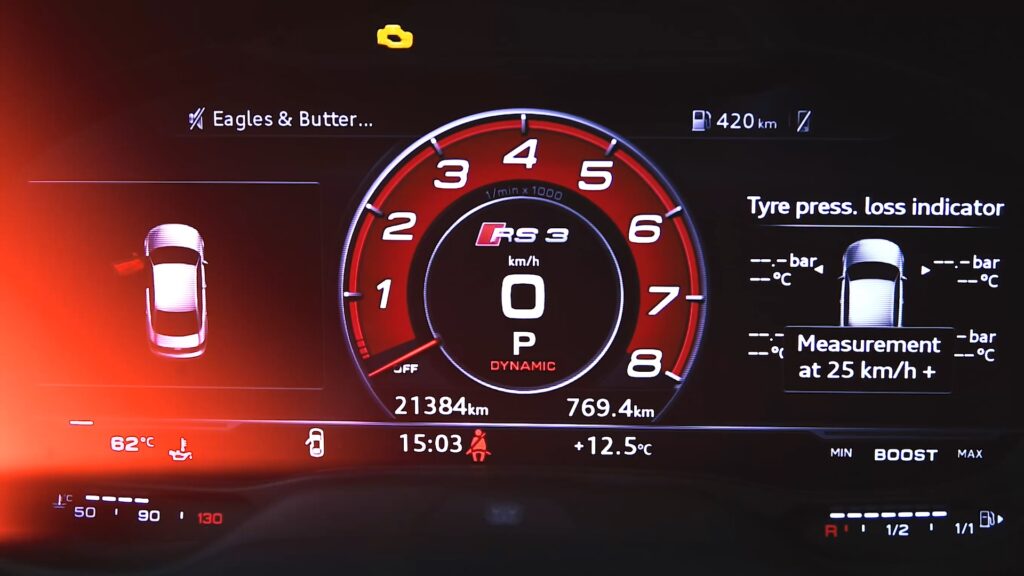
Audi RS3 & TTRS 8S – EA855 Evo
Tuning the Audi Mqb TTRS 8S – RS3 8V FL and RSQ3 with Gt-innovation software.
Back in the day, 5-cylinder cast iron block engines were a staple in the tuning industry, delivering impressive performance. However, our journey took an exciting turn in December 2016 when we first encountered the EA855 Evo MQB platform. It was a true case of love at first sight. Our test car, the TTRS 8S, which we acquired at that time, exceeded all our expectations.
In this post, we want to focus on the untapped potential of stock engine and turbo setups in TTRS, RS3, RSQ3 Daza, or Dnwa cars. Over the years, we’ve dedicated ourselves to developing custom functions, calibrations, and applications specifically tailored to this remarkable platform.
The marriage of the cutting-edge high-compression aluminum 5-cylinder engine (DAZA/DNWA), seamlessly paired with a responsive 7-speed DQ500 dual-clutch gearbox, a finely-tuned all-wheel-drive system, and the highly capable Bosch MED17 engine management system featuring an integrated traction control algorithm, seemed like a dream come true.
But we didn’t simply rest on our laurels with this remarkable combination; our journey was just beginning.
Our Development process
Our development journey kicked off promptly, with dedicated efforts directed towards refining both the gearbox and engine management system. As the days turned into nights, we poured countless hours into the intricate process of reverse engineering the firmware of the Bosch MED17.1.62 engine management system. Simultaneously, we rigorously tested new calibrations to uncover the true capabilities and boundaries of the engine.
Pushing the boundaries of a brand-new engine isn’t a walk in the park, and it certainly doesn’t come cheap—especially in 2016 when essential knowledge and information about this specific platform were scarce and hard to come by on the internet.
We embarked on a journey of experimentation, putting new components to the test and crafting innovative software functions. What began as an enjoyable daily driver swiftly evolved into an unparalleled powerhouse, capable of outperforming many supercars, surpassing even our wildest expectations.
Our commitment to excellence led us to conduct extensive high-speed and high-load tests on both the open road and our state-of-the-art AWD Mustang dynamometer. Thousands of hours were invested to ensure that every component we offer undergoes rigorous testing and performs flawlessly, meeting the highest standards of performance and reliability.
In the meantime, we welcomed yet another member to our EA855 Evo family, and this time, we had more room to work with. A pristine RS3 8V facelift arrived, eager to undergo a comprehensive tuning for every stage imaginable.
Each step of our journey has yielded rewarding results, as the car continually improved without showing any signs of significant wear or engine malfunctions. Our dedication to excellence has truly paid off.
Armed with our factory Etas ETK tools and various third-party devices, we embarked on the journey of testing our initial calibrations and gradually crafting new functions and algorithms. Yet, there remained a crucial element missing from the equation—a component that could infuse the system with the flexibility needed for seamless expansion and widespread distribution.
The tools
What we truly required was an entirely customizable in-house data logger—a versatile tool that could serve as both a debugger and flasher to streamline our development process. We envisioned a cost-effective, straightforward device-and-software combination that would not only accelerate our workflow but also enhance the overall quality of our product.
This vision led to the birth of the GT-Flasher and Logger, a dynamic UDS/OBDII software solution. This innovative tool is capable of programming, diagnosing, and logging data from the engine management system. It achieves this by harnessing the power of a J2534-compatible USB-to-OBD dongle, such as the Tactrix Openport 2.0
Our flasher boasts the remarkable capability to comprehensively program the factory Bosch MED17 engine management system, with plans to extend support to other systems in the near future. It accomplishes this task in an impressive under-8-minute timeframe, adhering diligently to all the official factory guidelines for a seamless firmware update procedure.
What sets our flasher apart is its resilience. In the event of an unexpected interruption, it can efficiently recover the flashing process. Additionally, it has the ability to reset the factory flash counters back to their default value of 1.
Our logger is highly versatile, supporting A2L Factory Data alongside standard DID OBD diagnosis channels. These channels can be effectively used to capture sensor measurements from the factory engine management system, utilizing the high-speed CAN BUS UDS protocol.
To make data acquisition seamless, our system allows online access to this information directly from our server. Furthermore, we’ve thoughtfully provided presets for every supported ECU, ensuring a user-friendly experience.
Reverse engineering the monster
To preserve and build upon the legacy of our earlier-generation Bosch MED17 engine management systems, we devoted nearly a year to a thorough process of reverse engineering the crucial ECU OEM functions. Our extensive knowledge of Infineon Tricore technology equips us with the expertise needed to tackle any task and seamlessly integrate a wide range of functions that enhance the user experience without compromising factory features or safety algorithms.
Through an in-depth analysis of the factory firmware, we unlocked the potential to create a set of distinctive and highly beneficial functions and algorithms. These innovations not only expanded the capabilities of engine management but also redefined the concept of ‘Tuning.’ Notably, we introduced essential engine safety features as part of our Multimap/Map-switch algorithm, designed to safeguard vehicle owners from catastrophic engine failures. These features include clear indications and fail-safe maps, offering a comprehensive safety net for vehicle performance enhancements.
In the following section, we’ll provide a concise overview of these remarkable achievements to offer you a glimpse into our groundbreaking work.
The Functions
Here is a brief list of our unique developments for this particular Bosch Med17.1.62 ecu.
- On the fly fully configurable Multimap / Map-switch function via cruise control
- Rolling Launch with throttle and boost control via Cruise control
- Fast Data-logging using our in house developed logger
- Ignition Retard Indication and fail-safe switch for extra protection
Multimap / Map-switch
Our system empowers users with access to four distinct map sets that can be effortlessly swapped while driving or at a standstill. This seamless transition is achieved with a simple action: lightly pressing the brake and the cruise control lever towards the minus sign. Each map set is meticulously designed and individually tuned, allowing drivers to navigate through a diverse range of calibrations tailored for various scenarios. These configurations encompass options for normal or ethanol-based fuel, low and high boost settings, as well as finely-tuned ignition profiles.
Below, we delve into the specific aspects our Multimap/Map-switch function allows users to switch among:
- All torque Limiters (Drivers wish and thresholds)
- All ignition Maps and Knock thresholds
- All fueling maps, correction maps, injector constants for normal or ethanol mixes
- All camshaft maps
- Traction control and launch control profiles
- All rpm Limits and displayed limits
- All sound modules (Burble / Pops and bangs)
- EGT model maps and exhaust Flap maps
More maps/modules could be added depending on the needs of the client.
Detailed presentation in English and German
https://www.youtube.com/watch?v=p0Ha5bWaOAE
The Fail-safe Function
Recognizing the variability in fuel quality and our unwavering commitment to ensuring the safety of high-performance engines, we’ve implemented a fail-safe algorithm. This advanced system continuously monitors each cylinder’s combustion process in real-time, providing proactive alerts to the user for any potential issues. When a problem is detected, it promptly triggers the EPC/MIL light to flash, while simultaneously switching the calibration to the stock or lower power output choice through our multi-map feature. This dual-action approach ensures the engine’s health and performance are safeguarded, even in the face of adverse conditions.
Cases like bad coil-packs, bad fuel quality, worn out spark plugs, injector failures are being easily caught by our safety algorithm that falls back to the safest calibration choice or any other calibration that is set as default.
Rolling Launch
The rolling launch functions is a unique option that we offer to our customers
Full Video Presentation :
Gearbox (TCU) calibration
With one of the finest Mechatronic units ever crafted, this gearbox is already lightning-fast and capable of handling substantial torque output and user demands. But could it be even better?
Absolutely. Many RS3 and TTRS owners have encountered driveability issues with the factory calibration. For instance, sudden transitions from part throttle to full throttle can lead to engine stalls, and the gearbox often struggles to determine whether to shift up or down, leaving the engine revving and the clutch partially engaged.
Moreover, the gearbox comes with several torque limiters, Vmax thresholds, and a clutch pressure that remains within the confines of a 15 software limit. Allow us to elucidate how we enhance the gearbox’s behavior and overall performance.
- Re-calibration of the gearshift torque intervention maps
- Vmax limiter removal
- Gearshift Timing reduction
- Gearshift rpm (KMH/MPH) extension for higher rev limiters
- Launch control parameters Re-calibration (Rpm, allowed torque)
- Full manual mode on M +/-
- Clutch pressure increment (Depends on the setup)
- Auto up-shift removal in any mode (If needed)
- Torque limiters up to 1000nm
- Clutch micro-slip adjustments
Our gearbox calibrations come packed with numerous enhancements and strategies to elevate the performance of the Bosch GSG DSG DQ500 Mechatronic unit. Notably, our calibrations deliver a level of smoothness in gearshifts that surpasses any other TCU calibrations available on the market for this specific platform, catering to both DAZA and DNWA – DQ500 Mechatronic setups.
While it’s important to note that the GT-Flasher currently does not support flashing of gearbox calibrations, a third-party flashing device is required. If you’re keen on flashing our custom DSG Calibration, don’t hesitate to reach out to us for guidance on the appropriate tools that can handle the job effectively.
The Particle Filter Era (OPF/PPF)
The DNW(A) engine was introduced as a direct replacement for the DAZA engine, primarily to align with stringent new emission regulations and successfully pass WLTP tests. This revamped engine now features a gasoline particle filter catalytic system, significantly reducing CO2 and particle emissions.
However, this commendable environmental upgrade comes at a cost: the distinctive and exhilarating sound of the iconic 5-cylinder engine has been toned down, and the playful burbles and pops are no longer present to comply with emission standards. Additionally, the impressive horsepower and torque figures, once benchmarked on dynamometers worldwide, are now brought in line with or even below factory specifications.
But fret not! In regions with less stringent emission standards, we have the capability to rekindle the beloved engine sounds to a certain extent. By incorporating specific exhaust components, we can also restore power levels to match or exceed those of DAZA-equipped vehicles.
The Numbers
Dynamo-meter Measurements.
As you can imagine, there exists a myriad of hardware combinations and various calibrations required to enhance the power output of this platform.
The primary limitation of a completely stock car is the undersized inter-cooler, which fails to provide efficient cooling, particularly in hot climates or under high boost conditions. Another limiting factor is the variability in fuel quality across different countries, which can significantly reduce power output, even with a stock software calibration.
Considering the factors mentioned above, we present a collection of dyno sheets that aim to address some fundamental questions about what can be achieved with a GT-Innovation tuned ECU for a stock turbocharged car.
It’s important to note that results may exhibit slight variations from one country to another, with a typical margin of 3% to 4%. This variation stems from disparities in factors such as fuel quality, temperature, altitude, and humidity. Despite the application of correction algorithms by most dynamometers, achieving precisely identical numbers in all cases remains a challenge.
stage 1 full stock 98
Stage 1+ opf 98/100 oct
stage 1 and 1+ full stock multi-map
stage 2 daza 100 octane + dsg with Upgrade intercooler – Upgrade intake and Downpipe
stage 2 and 2+ multimap 102 octane with Upgrade intercooler – Upgrade intake, inlet and Downpipe
Stage 2 + opf wmi + dsg with Upgrade intercooler – Upgrade intake, inlet and Downpipe built engine stock turbo
100-200kmh
on 98-100-102 octane fuel with the TTRS 8S and the RS3 8V FL
Races
As car enthusiasts, we’ve been actively involved in racing for years. Whether it’s a quarter-mile sprint or a challenging circuit, these events provide the perfect stage to showcase and put our extensive work to the test on a globally recognized platform.
One of the crucial tests we undertook to guarantee the optimal performance and engine protection of our software was conquering the challenging Green Hell, Nurburgring’s Nordschleife. This demanding track allowed us to push our software to the limits under the most grueling driving conditions and temperatures.
Known Problems
Waste-gate solenoid vacuum line
There is a black plastic vacuum line that follows the edge of the cylinder head from the center to the right and goes down to the side of the head where the pressure regulation valve is.
This small vacuum line gets melt or brakes up from too much heat. If the car is under-performing even as stock this vacuum line could be the reason.
Waste-gate rattle on Decat or Upgrade Downpipe
The most common sound after a down-pipe installation that comes from the exhaust is the waste-gate rattling one.
Why? simply because the factory calibration has different waste-gate profiles for different driving modes and in most of them the lower rpm area between 1500rpm and 2800rpm has a low waste-gate duty cycle set-point, causing the valve to open and close quickly and produce that annoying sound that some drivers thing it is engine related.
For this case our software upgrades include a Fix for those areas that will reduce up to 85% or eliminate completely the rattling sound on all driving modes.
The broken exhaust flaps
During our TTRS and RS3 ownership we had to replace the rear exhaust silencer flaps due to malfunctions usually on the side that is mostly closed on comfort and normal mode.
Further more many other clients and owners have reported such failures in several vehicles.
The weak Rods
The rumors are true, this engine is suffering from weak rods on high torque calibrations over 640 or 650 nm.Such power below 3400 rpm can cause rod failure or even a broken engine block.
Those engines can be run with bigger hybrid turbochargers without rod upgrades but failure is always a possibility and it is definitely dangerous for the engine, when the torque is not capped to a certain area in the power-band.
Dsg oil evaporation fumes
The stock evaporation filter from a Dq500 Bosch DSG-GSG gearbox that can be found in the TTRS 8S RS3 8V Facelift and RSq3 is not capable of keeping the amount of oil evaporation that the gearbox produces in certain cases.
The result is traces of oil at the drivers side area next to the airbox behind the headlight just before the engine management wiring harness plugs. An external upgraded catch can is required.
Oem Software bug on Calibrations
The oem stock software calibration, up to a certain version is known to have a bug in a particular ignition table that can cause engine failures on tuned cars if its not properly fixed.
Oem Inter-cooler inefficiency
The stock inter-cooler is the weakest point of this platform and the replacement has to be prioritized if the horsepower output has to be higher than a stage 1 software calibration.
Picture of the stock inter-cooler, to be replaced with a forge on a TTRS 8s
Upgrade forge inter-cooler
Upgrade CTS inter-cooler on RS3 8v Facelift
Cases to be covered in the next post
(E85) or Ethanol mixes calibration coverage.
Wmi usage and ignition maps
Big turbo applications (from hybrids to full frame kits)
Parts and upgrade kits































